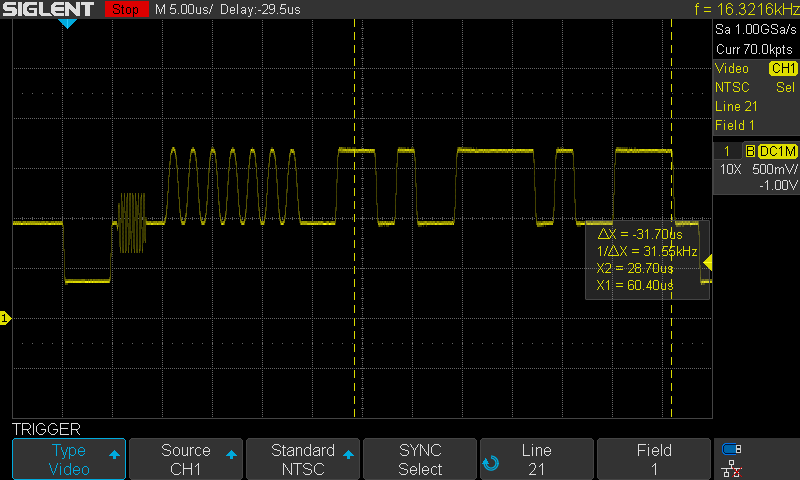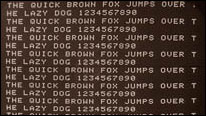|
EIA-608
EIA-608, also known as line 21 captions or CEA-608, is a standard used for displaying closed captioning on analog NTSC television broadcasts in the United States, Canada, and Mexico. Developed by the Electronic Industries Alliance (EIA), it allows text such as dialogue and sound effects to be shown on screen, helping people who are deaf or hard of hearing follow television programs. The system works by sending the caption data on a part of the TV signal that viewers don't normally see, called line 21 of the vertical blanking interval. In addition to captions, the standard also supports extra information known as "Extended Data Services" (XDS), which can include details like program titles or instructions for recording shows. This is similar to features found in some European TV systems that use a different signal format. Description EIA-608 captions are transmitted on either the odd or even fields of Line 21 with an odd parity bit in the non-visible active video data area in ... [...More Info...] [...Related Items...] OR: [Wikipedia] [Google] [Baidu] |
Closed Captioning
Closed captioning (CC) is the process of displaying text on a television, video screen, or other visual display to provide additional or interpretive information, where the viewer is given the choice of whether the text is displayed. Closed captions are typically used as a transcription of the audio portion of a program as it occurs (either verbatim or in edited form), sometimes including descriptions of non-speech elements. Other uses have included providing a textual alternative language translation of a presentation's primary audio language that is usually burned-in (or "open") to the video and unselectable. HTML5 defines subtitles as a "transcription or translation of the dialogue when sound is available but not understood" by the viewer (for example, dialogue in a foreign language) and captions as a "transcription or translation of the dialogue, sound effects, relevant musical cues, and other relevant audio information when sound is unavailable or not clearly audible" (fo ... [...More Info...] [...Related Items...] OR: [Wikipedia] [Google] [Baidu] |
EIA-708
CTA-708 (formerly EIA-708 and CEA-708) is the standard for closed captioning for ATSC digital television (DTV) streams in the United States and Canada. It was developed by the Consumer Electronics sector of the Electronic Industries Alliance, which later became the standalone organization Consumer Technology Association. Unlike RLE DVB and DVD subtitles, CTA-708 captions are low bandwidth and textual like traditional EIA-608 captions and EBU Teletext subtitles. However, unlike EIA-608 byte pairs, CTA-708 captions are not able to be modulated on an ATSC receiver's NTSC VBI line 21 composite output and must be pre-rendered by the receiver with the digital video frames, they also include more of the Latin-1 character set, and include stubs to support full UTF-32 captions, and downloadable fonts. CTA-708 caption streams can also optionally encapsulate EIA-608 byte pairs internally, a fairly common usage. CTA-708 captions are injected into MPEG-2 video streams in the picture u ... [...More Info...] [...Related Items...] OR: [Wikipedia] [Google] [Baidu] |
Teletext
Teletext, or broadcast teletext, is a standard for displaying text and rudimentary graphics on suitably equipped television sets. Teletext sends data in the broadcast signal, hidden in the invisible vertical blanking interval area at the top and bottom of the screen. The teletext decoder in the television buffers this information as a series of "pages", each given a number. The user can display chosen pages using their remote control. In broad terms, it can be considered as Videotex, a system for the delivery of information to a user in a computer-like format, typically displayed on a television or a dumb terminal, but that designation is usually reserved for systems that provide bi-directional communication, such as Prestel or Minitel. Teletext was created in the United Kingdom in the early 1970s by John Adams, Philips' lead designer for video display units to provide closed captioning to television shows for the hearing impaired. Public teletext information services were ... [...More Info...] [...Related Items...] OR: [Wikipedia] [Google] [Baidu] |
NTSC
NTSC (from National Television System Committee) is the first American standard for analog television, published and adopted in 1941. In 1961, it was assigned the designation System M. It is also known as EIA standard 170. In 1953, a second NTSC standard was adopted, which allowed for color television broadcast compatible with the existing stock of black-and-white receivers. It is one of three major color formats for analog television, the others being PAL and SECAM. ''NTSC color'' is usually associated with the System M; this combination is sometimes called NTSC II. The only other broadcast television system to use NTSC color was the System J. Brazil used System M with PAL color. Vietnam, Cambodia and Laos used System M with SECAM color – Vietnam later started using PAL in the early 1990s. The NTSC/System M standard was used in most of the Americas (except Argentina, Brazil, Paraguay, and Uruguay), Myanmar, South Korea, Taiwan, Philippines, Japan, and some Pacific Isl ... [...More Info...] [...Related Items...] OR: [Wikipedia] [Google] [Baidu] |
Exclamation Mark
The exclamation mark (also known as exclamation point in American English) is a punctuation mark usually used after an interjection or exclamation to indicate strong feelings or to show wikt:emphasis, emphasis. The exclamation mark often marks the end of a sentence, for example: "Watch out!". Similarly, a bare exclamation mark (with nothing before or after) is frequently used in warning signs. Additionally, the exclamation mark is commonly used in writing to make a character seem as though they are shouting, excited, or surprised. Other uses include: * In mathematics, it denotes the factorial operation. * Several computer languages use at the beginning of an expression (computer science), expression to denote logical negation. For example, means "the logical negation of A", also called "not A". This usage has spread to ordinary language (e.g., "!clue" means no-clue or clueless). * Some languages use ǃ, a symbol that looks like an exclamation mark, to denote a click consonant. ... [...More Info...] [...Related Items...] OR: [Wikipedia] [Google] [Baidu] |
SMPTE 291M
Ancillary data is data that has been added to given data and uses the same form of transport. Common examples are cover art images for media files or streams, or digital data added to radio or television broadcasts. Television Ancillary data (commonly abbreviated as ANC data), in the context of television systems, refers to a means which by non-video information (such as audio, other forms of essence, and metadata) may be ''embedded'' within the serial digital interface. Ancillary data is standardized by SMPTE as ''SMPTE 291M: Ancillary Data Packet and Space Formatting''. Ancillary data can be located in non-picture portions of horizontal scan lines, known as Horizontal ANCillary data (HANC). Ancillary data can also be located in non-picture regions of the video frame, known as Vertical ANCillary data (VANC). Technical details Location Ancillary data packets may be located anywhere within a serial digital data stream, with the following exceptions: * They should not be located ... [...More Info...] [...Related Items...] OR: [Wikipedia] [Google] [Baidu] |
SMPTE 259M
SMPTE 259M is a standard published by SMPTE which "describes a 10-bit serial digital interface operating at 143/270/360 Mb/s." The goal of SMPTE 259M is to define a serial digital interface (based on a coaxial cable), called SDI or SD-SDI. There are 4 bit rate In telecommunications and computing, bit rate (bitrate or as a variable ''R'') is the number of bits that are conveyed or processed per unit of time. The bit rate is expressed in the unit bit per second (symbol: bit/s), often in conjunction ...s defined, which are normally used to transfer the following standard video formats: References Film and video technology SMPTE standards {{Measurement-stub ... [...More Info...] [...Related Items...] OR: [Wikipedia] [Google] [Baidu] |
Material Exchange Format
Material Exchange Format (MXF) is a container format for professional digital video and audio media defined by a set of SMPTE standards. A typical example of its use is for delivering advertisements to TV stations and tapeless archiving of broadcast TV programs. It is also used as part of the Digital Cinema Package for delivering movies to commercial theaters. Summary MXF, when used in the form of "Operational Pattern OP1A" or "OPAtom", can be used as a ''container'', ''wrapper'' or ''reference file'' format which supports a number of different streams of coded "essence", encoded in any of a variety of video and audio compression formats, together with a metadata wrapper which describes the material contained within the MXF file. Other "Operational Patterns" can contain or reference multiple materials, just like a simple timeline of a video editing program. MXF has full timecode and metadata support and is intended as a platform-agnostic stable standard for future professio ... [...More Info...] [...Related Items...] OR: [Wikipedia] [Google] [Baidu] |
Space (punctuation)
In writing, a space () is a blank area that word divider, separates words, Sentence spacing, sentences, and other written or printed glyphs (characters). Conventions for spacing vary among languages, and in some languages the spacing rules are complex. Inter-word spaces ease the reader's task of identifying words, and avoid outright ambiguities such as "now here" vs. "nowhere". They also provide convenient guides for where a human or program may start new lines. Typesetting can use spaces of varying widths, just as it can use graphic characters of varying widths. Unlike graphic characters, typeset spaces are Typographic alignment, commonly stretched in order to align text. A typewriter, on the other hand, typically has only one width for all characters, including spaces. Following widespread acceptance of the typewriter, some typewriter conventions influenced typography and the design of printed works. Computer representation of text facilitates getting around mechanical and phys ... [...More Info...] [...Related Items...] OR: [Wikipedia] [Google] [Baidu] |
Number Sign
The symbol is known as the number sign, hash, (or in North America) the pound sign. The symbol has historically been used for a wide range of purposes including the designation of an ordinal number and as a Typographic ligature, ligatured abbreviation for Pound (mass), pounds avoirdupois – having been derived from the now-rare . Since 2007, widespread usage of the symbol to introduce metadata tags on social media platforms has led to such tags being known as "hashtags", and from that, the symbol itself is sometimes called a hashtag. The symbol is distinguished from similar symbols by its combination of level horizontal strokes and right-tilting vertical strokes. History It is believed that the symbol traces its origins to the symbol , an abbreviation of the Roman term ''Roman pound, libra pondo'', which translates as "pound weight". The abbreviation "lb" was printed as a dedicated Ligature (writing), ligature including a horizontal line across (which indicated abbreviation ... [...More Info...] [...Related Items...] OR: [Wikipedia] [Google] [Baidu] |
Apostrophe (punctuation)
The apostrophe (, ) is a punctuation mark, and sometimes a diacritical mark, in languages that use the Latin alphabet and some other alphabets. In English, the apostrophe is used for two basic purposes: * The marking of the omission of one or more letters, e.g. the contraction of "do not" to "don't" * The marking of possessive case of nouns (as in "the eagle's feathers", "in one month's time", "the twins' coats") It is also used in a few exceptional cases for the marking of plurals, e.g. "p's and q's" or Oakland A's. The same mark is used as a single quotation mark. It is also substituted informally for other marks for example instead of the prime symbol to indicate the units of foot or minutes of arc. The word ''apostrophe'' comes from the Greek (hē apóstrophos rosōidía ' he accent ofturning away or elision'), through Latin and French. Usage in English Historical development The apostrophe was first used by Pietro Bembo in his edition of '' De Aetna'' (1496). ... [...More Info...] [...Related Items...] OR: [Wikipedia] [Google] [Baidu] |



